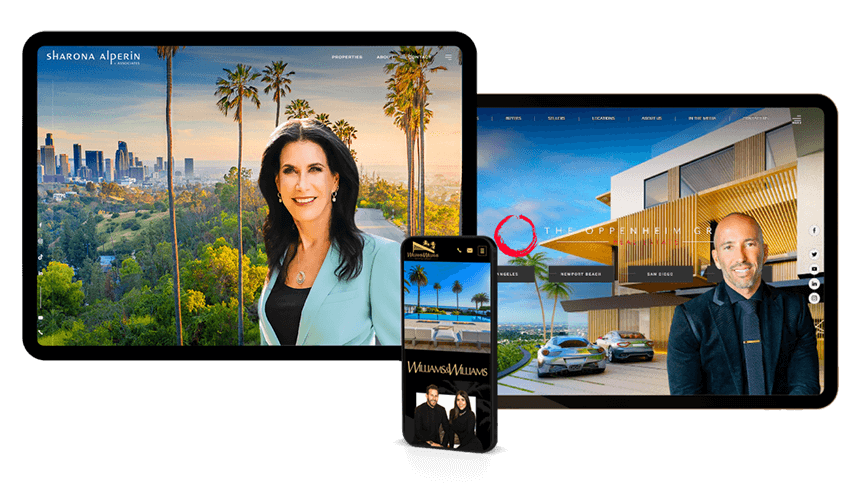The Power of Color in Real Estate Branding
Have you noticed that some colors are more common in real estate logos than others?
Just as fashion labels and car brands rely on distinct personalities to connect with their customers, real estate companies use color to shape their identity and communicate their unique values.
Color psychology plays an essential role in marketing. The colors you use on your website, business cards, logo, and listings have the potential to affect your customers’ actions. They convey different messages, and choosing the most appropriate one for your brand helps you establish your brand personality.
Table of Contents
Want to talk with a real estate marketing expert instead?
Reach out for a free consultation here.
What is a brand personality?
A brand personality is a set of characteristics that are associated with a brand name. For example, Nike can be described as bold and exciting, while Harley Davidson is rugged and gritty.
Having a brand personality humanizes your brand and allows it to connect with your target audience in meaningful ways. And a great marketing campaign is all about that connection. Employing color psychology is one of the many ways to strengthen your brand personality and campaign effectiveness.
The Colors Of Real Estate
The most commonly used colors in real estate—blue, red, black, green, and orange—each tell a story.
-
Blue — Blue is the color of choice for many industry leaders. It signifies dependability, honesty, trustworthiness, and strength. Coldwell Banker’s logo is a great example of this.
-
Red — Strong, brave, and confident are some of the universal meanings associated with the color red. Take a look at the Keller Williams logo — its use of red and gray makes it eye-catching. Combined with strong typography, Keller Williams’ branding is immediately memorable.
-
Black — For companies who want to convey a sense of sophistication and elegance, black is an excellent choice. Many real estate firms like Gary Gold and Aaron Kirman Properties, which specialize in exclusive luxury homes, choose black for their logos, sometimes with gold or silver accents.
-
Green — Green symbolizes calmness, fertility, growth, and stability. Real estate professionals specializing in family homes may like green for this reason. Sosua Cabarete Real Estate’s website uses the color green abundantly, which complements the lush tropical properties they represent.
-
Orange — Orange is a cousin to red in terms of energy and excitement. It’s also a popular logo color in communities that feature beaches or oceans. Real estate agents often use the color to convey sunshine and enthusiasm. Nan & Co Properties’ custom website is a brilliant example of this color in action.
-
Other colors — There’s no rule that says you can’t choose different colors for your logo. Just keep in mind that the best colors are those that are easy to read and convey the message you want to send. For instance, brown and green often suggest nature to most viewers. Using this combination in rural property logos or to suggest that you specialize in “green” housing is an effective use of color.
Connect with a marketing expert
Using Colors To Reinforce Your Real Estate Brand
Understanding the psychology of color is only half the equation; the real power lies in applying it to bring your brand’s identity to life. By strategically choosing and placing colors, you can strengthen your brand’s personality, making it instantly recognizable and emotionally engaging for potential clients. Here are some actionable tips to help you leverage color psychology effectively and build a brand that resonates deeply with your target audience.
-
Know your brand personality
There's no effective marketing without first defining in clear terms what you want your brand personality to be. In one of the most widely used models, Jennifer Aaker, a psychologist and professor, identifies five different dimensions of brand personality:
-
Sincerity
-
Excitement
-
Competence
-
Sophistication
-
Ruggedness
According to Aaker, a brand has one dominant dimension, though they can also be a cross between two traits. As a real estate agent, you might describe your brand personality as both competent and sophisticated, or sincere and excited. Going back to color psychology, Aaker agrees there are certain colors that align with specific traits, such as red for excitement and purple for sophistication.
-
-
Choose colors that differentiate your brand
While there are well-known meanings behind popular colors, it’s far more important to use color to project the personality you want, instead of simply aligning the brand with stereotypical colors. Some experts go as far as to say that marketers should use color to differentiate their brand from major competitors.
Choosing a color that differentiates your brand should be based on several criteria, some of which include:
-
Your target audience – Who are they, what do they care about, and what mood should they be in to be able to engage with your brand? Consumers are affected by colors in different ways, and cultural trends affecting this are constantly in transition.
-
Culture – Colors mean different things to individuals in different parts of the world. In the United States, white stands for purity. But in Asian countries like China and Korea, it’s the color of death and mourning.
-
Brand archetype – Archetypes originate from the work of psychiatrist Carl Jung, who delved into the role myths and symbols played in human thinking. Although each individual is unique, people have shared traits that enable us to classify and make sense of ourselves.
The same goes for brands — consumers personify brands, giving them meaning and establishing relationships with them based on what they stand for, and what kind of emotions they inspire.
-
-
Add context to the color
The color green is generally perceived to have a calming effect. But this interpretation of the color is too broad and lacks context. Being specific with the colors that you choose is important; for instance, green is used by Whole Foods to communicate freshness and sustainability, but it’s also used by the streaming service Spotify to signify creativity and growth.
-
Pick an appropriate color
There’s another important layer to consider when choosing the right color: perceived appropriateness. Research suggests that this perception is even more important than the color itself.
Consumers know intuitively whether a brand and a color connect. If they don’t connect, consumers get turned off. This means that the color used to represent the brand should be a good fit for the product or service that is being sold. For example, American Airlines incorporates the colors of the flag in its logo, which echoes its status as a major airline in the United States.
Frequently Asked Questions
Colors are critical in real estate branding as they shape first impressions and build brand recognition. Strategic use of color helps convey trustworthiness, professionalism, and reliability, which are essential in real estate transactions.
A 2006 study suggests that color alone impacts up to 90% of consumer judgments on brands.
Color psychology influences potential buyers by creating a visual atmosphere that aligns with their emotions and values, setting the tone before they’ve even spoken with an agent. For example, a well-chosen color palette can subtly communicate your brand’s stability, friendliness, or exclusivity, which helps establish trust and comfort from the start.
Color choices also impact decision-making speed, especially in competitive markets; a strategic use of accent colors, like a bold hue for calls-to-action, can motivate quicker responses from buyers scrolling through listings.
Know your brand identity first. Are you aiming for upscale elegance or a warm, approachable feel? Use a primary color to define your brand, a secondary to support it, and an accent to create visual pops. Balance and test until you have a cohesive look. If you’re unsure what direction to take, it’s always best to consult with an art director who can help you define this critical piece of your real estate brand.
Your color scheme can make or break the website’s feel. Soft blues and neutrals create a welcoming, professional look, while bolder hues like red signal urgency or action points. When designing a custom website, sticking to the 60-30-10 rule (dominant, secondary, accent) keeps it sleek and functional.
Avoid overusing bright colors, which can be visually overwhelming and may detract from a professional look. Clashing colors can also confuse brand messaging, so it’s important to test combinations and gather feedback from design experts as well as your actual customers.
Choose colors that reflect these aspects and match the emotional tone you want clients to associate with your brand. Testing your palette across different materials (website, business cards, and signage) can also help ensure cohesion and consistent messaging.
Colors that look vibrant on digital screens might appear dull in print, so adjusting brightness or tone for print materials can help maintain brand integrity. Maintaining a core palette that works well in both mediums will keep your branding consistent and recognizable across platforms, which is what’s important.
Create a Custom Website with Agent Image
Ready to level up your real estate business? At Agent Image, we create custom websites that help you stand out. Schedule your free consultation today or give us a call at 1.800.979.5799.





